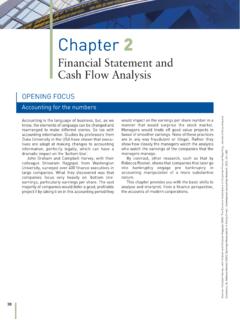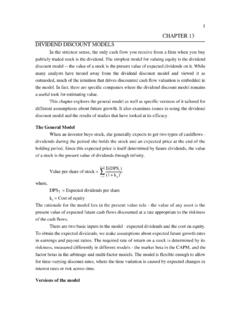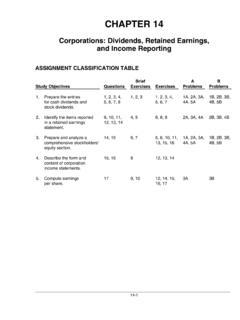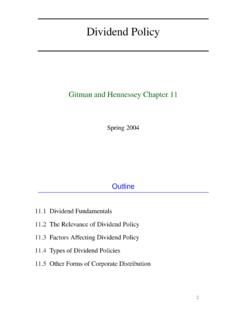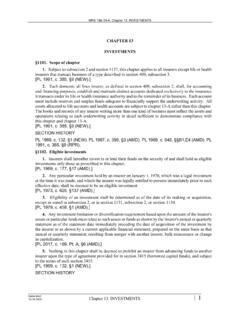Transcription of Chapter 16 Dividend Policy - Textbook Media
1 Chapter 16. Dividend Policy Overview: Dividends are the cash payments that corporations make to their common stockholders. This Chapter explores the importance of these payments, the factors that determine a firm's Dividend Policy , and the leading theories of why and how firms should pay dividends. The Chapter also explains the process of paying cash dividends and the differences between cash and stock dividends. What You Should Know From This Chapter : 1. Explain the importance of and identify the factors that influence the Dividend decision: Since investors evaluate companies based on future cash flows, the estimation of Dividend payments is an important component of this valuation process. A well- planned Dividend Policy that does not result in surprises to market participants will thus prevent investors from making sudden changes in their attitudes toward a firm's stock that might cause its price to fluctuate.
2 Dividend Policy is based on a firm's need for funds, the firm's cash position, its future financial prospects, stockholder expectations, and contractual restrictions with which the firm might have to comply. A firm that is short of cash or one that has limited borrowing capacity will generally pay lower dividends than one that has few attractive capital budgeting projects and a lot of cash. Managers also consider the firm's future prospects in deciding on Dividend Policy because they do not want to have to reduce the dividends in the future. They also may have future capital projects planned that will require cash reserves. If a firm knows that its particular stockholders have a preference for lower-taxed capital gains over taxable Dividend income, it may pay less in dividends.
3 A ratio often used to describe a firm's Dividend Policy is the Dividend payout ratio, which is calculated as total dividends paid divided by net income. 2. Compare the major Dividend theories: The main theories that help guide and explain Dividend Policy are the residual theory, the clientele theory, the signaling theory, the bird-in-the-hand theory and the Modigliani and Miller theory. The residual theory hypothesizes that firms will focus on what they need to retain rather than what they want to pay out. Therefore, dividends will be determined by how much is left over after they have used earnings for capital investment projects. Although this may be optimal for 198. the firm, it is likely to result in irregular Dividend payments which may not be consistent with stockholder preferences.
4 The clientele theory is based on the idea that investors are attracted to firms that have Dividend policies that fit their particular needs. Thus, some investors, such as those on fixed incomes and those that are not in high tax brackets, may be attracted to firms that have high Dividend payout ratios. Other investors may prefer to have their earnings reinvested in the firm rather than receive taxable dividends. Under this theory, a firm should stick to a particular Dividend Policy to keep their clientele happy. The signaling theory suggests that management declares Dividend increases when it expects to be able to support those increases in the future. Therefore, Dividend changes are seen as signals of management's inside information on the prospects of the firm.
5 Since a Dividend decrease would cause investors to think that the firm had bad prospects, managers try not to increase dividends beyond a level that they can maintain in the future. The bird-in-the-hand theory claims that stockholders generally prefer dividends over capital gains because they are lower risk than waiting to receive the returns in the form of stock price appreciation. This would imply that the stocks of firms that pay dividends would be more popular and would have lower required returns than stocks of firms that reinvest earnings. Modigliani and Miller (commonly referred to as M&M) originally theorized that Dividend Policy is irrelevant to the value of the firm. Since they based their proof on fairly restrictive assumptions, this result has not been shown to hold in the real world.
6 However, it was a starting point for much of modern financial theory in this area. 199. 3. Describe how a firm pays dividends: Dividend Policy is made by the board of directors. On the declaration date, the board will declare the amount of Dividend to be paid to owners as of a particular cut-off date called the date of record. Four days before the date of record, common stock that has an upcoming Dividend payment will begin to trade ex- Dividend , which means that investors who buy the stock on or after that date will be buying it without the entitlement to the forthcoming Dividend . This four-day period is given so that there is sufficient time to determine where to mail the Dividend for each shareholder. A few weeks after the date of record, on the payment date, the checks will be mailed to the common stockholders.
7 The time line is as follows: Declaration 4 days prior Date Payment date to date of record of record date | | | |. Board announces Stock begins to trade All who hold common Dividend checks Dividend will be paid ex- Dividend stock on this day will are mailed to all receive the Dividend holders of record Many firms now offer Dividend reinvestment plans (DRIPS) which allow shareholders to reinvest their dividends rather than receive them in cash. 4. Identify alternatives to paying cash dividends. Sometimes corporations want to give stockholders something even though there is not sufficient cash to pay a cash Dividend . Alternatively, they may not want to pay a cash Dividend because they are attempting to build up their cash position.
8 In those circumstances, the board of directors may decide to issue additional shares and give them to their shareholders. When a stock Dividend is declared, the existing shareholders receive new shares proportionate to the number of shares currently held. This is usually expressed as a percentage of the existing holdings. If the percentage is 25% or more, a stock split is usually done. Both stock splits and stock dividends increase the number of shares outstanding and decrease the price per share; investors often see these actions as a positive signal even though earnings and risk are not affected. 200. Terminology and Concept Review 16-1. Cash payments that corporations make to their common stockholders are called _____.
9 16-2. Dividend Policy is decided upon by the _____. 16-3. The _____ theory of dividends hypothesizes that the firm should focus on the need for retaining earnings and pay dividends from what is left over after all desirable capital projects are funded. 16-4. The _____ Dividend theory implies that managers will try to pay the Dividend that is expected by investors even if it means turning down attractive investment opportunities because a Dividend decrease will cause investors to think that the firm is in trouble. 16-5. The _____ Dividend theory is based on the view that investors are attracted to a particular company because of its Dividend Policy . Under this theory, the management should avoid making changes in Dividend Policy .
10 16-6. The _____ theory of dividends claims that shareholders prefer to receive dividends rather than to have earnings reinvested in the firm on their behalf because of the uncertainty associated with future capital gains. 16-7. Investors who buy a share of stock on or after the _____. date, four days before the date of record, will be buying it without the right to receive the upcoming Dividend . 16-8. Companies will pay the Dividend to all stockholders who are on the books as of the _____. 16-9. When a _____ Dividend is declared, the existing stockholders receive new shares, proportionate to the number of shares they already own, instead of cash. 16-10. When a stock Dividend would increase the number of shares by 25% or more, the corporation generally declares a _____.








